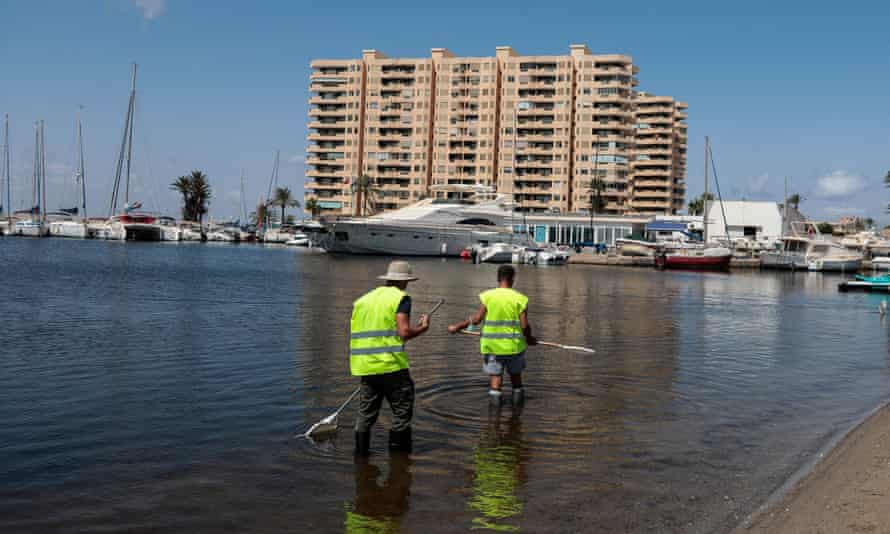Spain bans fertilisers near saltwater lagoon after dead fish wash up
Officials close eight beaches as residents complain of cloudy, green water that emits a foul smell

Last modified on Thu 26 Aug 2021 15.05 EDT
Spanish officials have banned the use of fertilisers near one of Europe’s largest saltwater lagoons after five tons of dead fish washed up on its shores.
Alarm bells began to sound in the south-eastern region of Murcia last week as scores of small fish and shrimp began to wash up along the beaches of the Mar Menor lagoon.
Regional officials closed eight beaches as residents complained that the waters of the lagoon, once popular with tourists, were cloudy, green and emitting a foul odour.
Dead fish continue to turn up more than a week later, albeit in smaller numbers, said Angel Sallent, a biologist with Anse, a conservation group focused on south-east Spain.
The five-ton figure calculated by the regional government is likely to be an underestimate, he said. “We’ve done dives and we could see that there were dead fish on the seabed. We’ll likely never be able to quantify the number of animals that have died,” he said.
Ecologists have warned for years that life in the lagoon is being suffocated by decades of nitrate-laden runoffs, mostly from agriculture, that trigger vast algae blooms – described as extreme eutrophication – that deplete the water of oxygen.
The lagoon sits next to the Campo de Cartagena, an expansive area of intensive agriculture that has swelled tenfold in four decades. Stretching to about 60,000 hectares, the area has helped transform the region into one of Spain’s main producers of fruits and vegetables. Much of its produce ends up at supermarkets across northern Europe.
The lagoon has also come under pressure from poor sewage systems in nearby towns, which have boomed in recent decades as tourism grows, and discharge from mining activities.
Ecologists’ concerns intensified in 2016 after algal blooms turned the waters of Mar Menor green and killed off 85% of the marine vegetation on its seabed, and again in 2019 after thousands of dead fish and crustacea washed up in the same area.
Spain’s environment minister, Teresa Ribera, accused regional officials on Wednesday of turning a blind eye to irregularities in the agricultural fields near the lagoon.
She highlighted 8,000 hectares of land that lack “adequate irrigation rights”, meaning some were “illegally extracting water or using a quantity far above their allocation”.
Agricultural groups have long rejected such claims, arguing they comply with all environmental legislation.
Wednesday’s ban on the use of inorganic nitrogen fertilisers within 1.5km of the lagoon was welcomed by ecologists, who have spent years calling for action. “We think it’s a good step but it comes very late,” said Sallent.
He called on the regional and central government to take urgent action, such as curbing the intensive agricultural practices of the area and creating wetlands around the lagoon that could act as “green filters”. Failure to do so risks incidents similar to that of the past week becoming more frequent.
“It’s unfortunate. This was a jewel, a singular site that at one point could have been a national park,” he said. “But instead, in the 1970s and 1980s, it bet on aggressive urban development and later intensive agriculture that was also very aggressive. They prioritised these economic sectors and they forgot the environment.”
